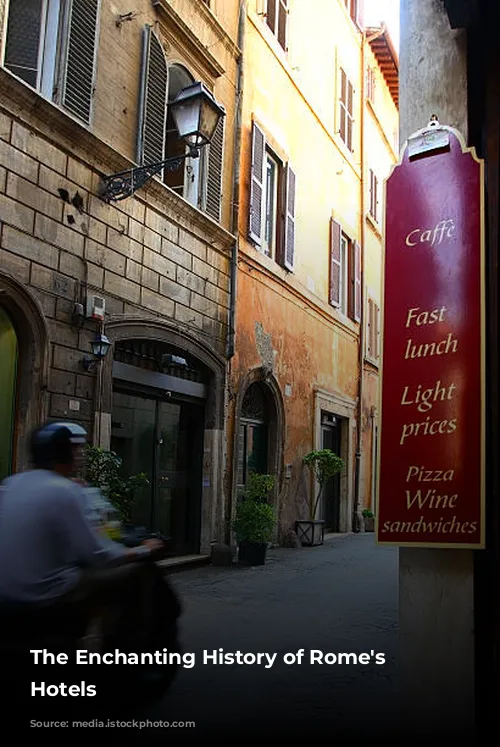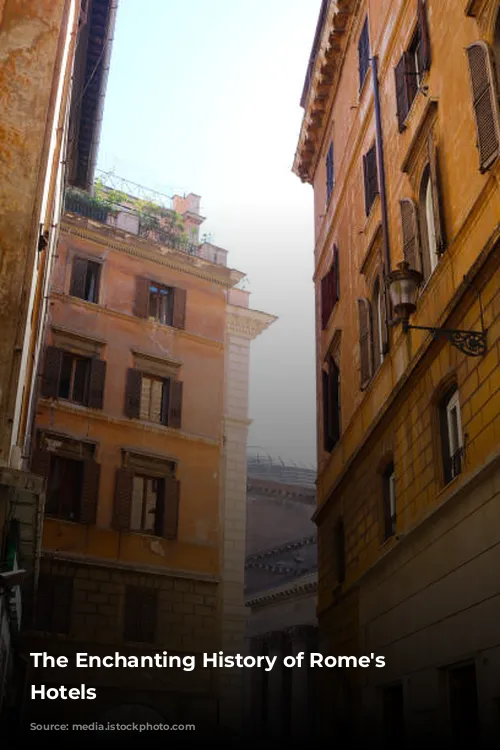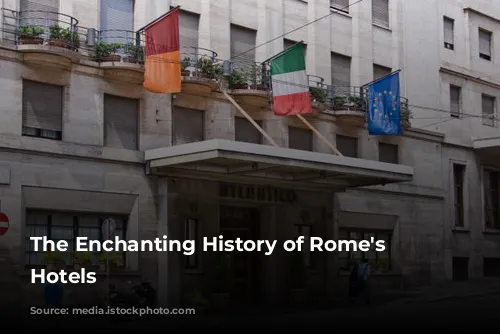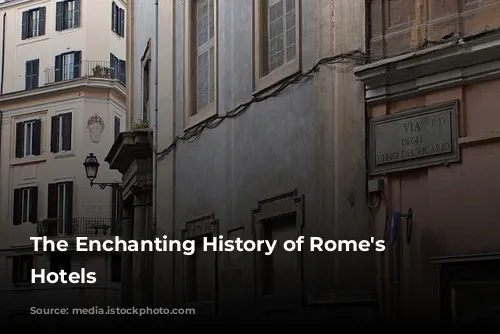Imagine a city brimming with ancient history and captivating charm. Rome, the Eternal City, is more than just ruins and iconic landmarks. It’s a tapestry woven with centuries of stories, whispers of kings and artists, and the lingering essence of bygone eras. This rich legacy is woven into the fabric of Rome’s historic hotels, each one a living testament to the city’s enduring allure.
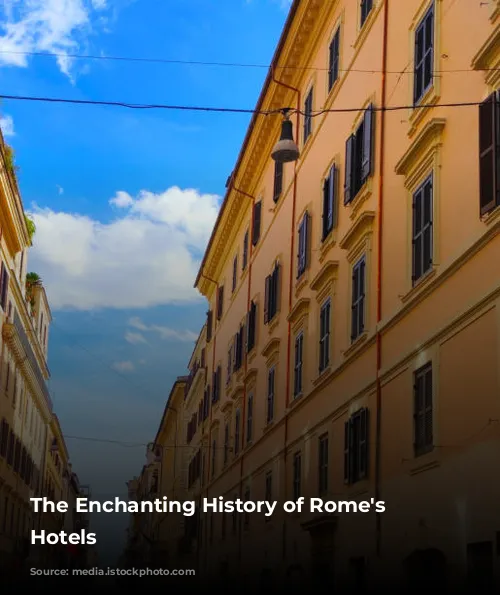
Time Capsules of Luxury and Legacy
Stepping into a historic Roman hotel is like stepping into a time capsule. These grand structures, some dating back to the Renaissance, have witnessed history unfold within their walls. From the first inns to the grand hotels of the Belle Époque, these palaces have played host to a constellation of luminaries – writers, artists, scientists, royalty, and diplomats, each leaving their mark on the very fabric of the hotel’s history.
The oldest hotel in Rome, the Albergo del Sole, formerly known as the Locanda del Montone, is an intimate haven boasting a beautiful garden and 18th-century frescoes. Its legacy stretches back to 1467, when it welcomed the troops of Emperor Frederick III. The hotel’s guest list reads like a who’s who of history, including the alchemist Count of Cagliostro and, in more recent times, the iconic duo Jean-Paul Sartre and Simone de Beauvoir.
A stone’s throw away, the Grand Hotel de la Minerve, built in 1620 as the residence of the Portuguese Fonseca family, holds the title of Rome’s first grand hotel.** Transformed into a luxurious haven in 1835 by the French Sauve family, it boasts suites named after its illustrious guests, including the literary giants Stendhal, Herman Melville, and George Sand.
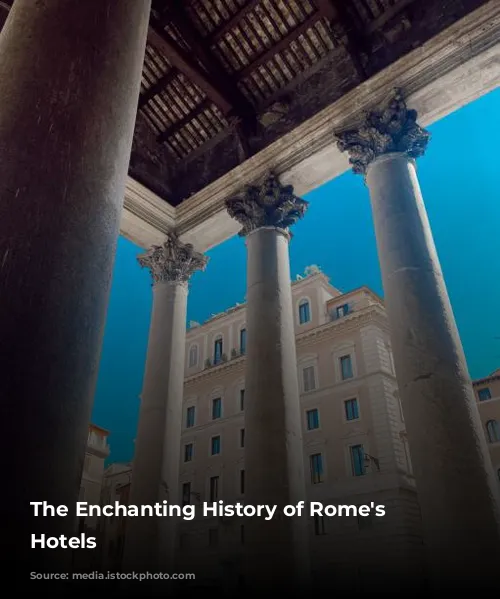
Grand Architecture and Timeless Elegance
Moving into the heart of Rome, the Tridente area, the Grand Hotel Plaza stands as a monument to architectural grandeur and timeless elegance. Born as an inn in the final years of Papal Rome, it quickly transformed into a gathering place for the city’s elite – nobles, artists, politicians, and royalty. The hotel’s windows once framed the spectacle of the Roman Carnival, with the Savoy princes Umberto and Margherita amongst its privileged spectators.
Just outside the city’s Porta del Popolo gate, the Hotel de Russie, nicknamed “Hotel of the Kings,” is a haven of elegance and history. This exquisite hotel, transformed into a grand establishment in the late 19th century, has welcomed a veritable royal procession – the Romanovs, Prince Jérôme Napoléon, King Gustav of Sweden, and the Bulgarian monarchs Ferdinand and Boris. Its secret garden, designed by the renowned architect Giuseppe Valadier, is a hidden oasis of beauty, visible only from the hotel’s back, cascading down terraces towards the Pincio.
Across Piazza del Popolo, the Hotel Locarno stands as a jewel of Art Nouveau design. Inaugurated in 1925, it became a magnet for the artistic and intellectual elite, hosting luminaries like Jean-Michel Basquiat and Jorge Luis Borges.

A Canvas for History and Glamour
Perched atop the Spanish Steps, the Hotel Hassler Villa Medici, founded in 1893, is a breathtaking blend of luxury and history. This legendary hotel, frequented by the world’s political, economic, and cultural elite, has welcomed the likes of the Kennedy family, Prince Rainier and Grace Kelly, Charlie Chaplin, and Gabriel Garcia Marquez.
The Sina Bernini Bristol hotel, with its enviable terrace overlooking the city, offers a glimpse of Roman grandeur. Inaugurated in 1874, the hotel was completely rebuilt in the 1940s, adding the name of the renowned artist Gian Lorenzo Bernini to its title. This grand hotel has hosted a galaxy of stars, including the Emperor of Brazil, the Princes of Wales, and the Rockefellers.

The Buzz of Via Veneto: Where History Meets Glamour
Via Veneto, one of Rome’s most iconic streets, is a vibrant tapestry of history and glamour. From its birth in the Belle Époque to its transformation into a haven for movie stars and artists in the 1950s and 1960s, it has become synonymous with the “Dolce Vita.”
The Majestic Hotel, the street’s first grand hotel, built in 1889, is a testament to architectural brilliance. Its unique design, tapestries, luxurious furniture, and frescoes by Domenico Bruschi have made it a magnet for royalty, princes, princesses, and Hollywood stars.
The Palace Hotel, built in 1900, was originally intended to house diplomats. After serving as the American Embassy Library following World War II, it reopened in the 1990s as the Ambasciatori Palace, retaining its original charm and exquisite details.
The Grand Hotel Palace, dating back to 1927, is a breathtaking example of Roman modernist architecture. Designed by Marcello Piacentini, it bridges the gap between Art Nouveau and Art Deco. Its timeless elegance is enhanced by stunning frescoes by the Venetian artist Guido Cadorin, capturing the hotel’s history and the artistic spirit of the era.
Rome’s historic hotels are more than just places to stay; they are living museums, each one a captivating chapter in the city’s story. They offer a glimpse into the past, allowing visitors to experience the charm and grandeur of bygone eras, and to feel the pulse of history beating beneath the cobblestones of this timeless city.
